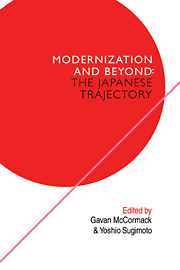Book contents
- Frontmatter
- Contents
- Contributors
- Introduction: modernization and beyond
- I Popular culture: tradition and ‘modernization’
- II Popular movements: alternative visions of ‘modernization’
- III Uneven development and its discontents
- IV Sex, politics and ‘modernity’
- 9 The Japanese women's movement: the counter-values to industrialism
- 10 Male homosexuality as treated by Japanese women writers
- 11 Body politics: abortion law reform
- 12 Division of labour: multinational sex in Asia
- V ‘Modernization’ and ‘modernity’: theoretical perspectives
- Glossary
- Index
12 - Division of labour: multinational sex in Asia
Published online by Cambridge University Press: 04 August 2010
- Frontmatter
- Contents
- Contributors
- Introduction: modernization and beyond
- I Popular culture: tradition and ‘modernization’
- II Popular movements: alternative visions of ‘modernization’
- III Uneven development and its discontents
- IV Sex, politics and ‘modernity’
- 9 The Japanese women's movement: the counter-values to industrialism
- 10 Male homosexuality as treated by Japanese women writers
- 11 Body politics: abortion law reform
- 12 Division of labour: multinational sex in Asia
- V ‘Modernization’ and ‘modernity’: theoretical perspectives
- Glossary
- Index
Summary
INTRODUCTION
In recent years, the problem of so-called ‘sex tours’ to South East Asia by Japanese tourists has been taken up by the Japanese media. Every year hundreds of thousands of Japanese tourists, predominantly male, travel to Korea, the Philippines, or other South East Asian countries. The main attraction is prostitution. Is this a new phenomenon, or is it merely part of a long history of the exploitation of female sexuality in the process of Japan's modernization?
Prostitution has long been an important part of Japanese culture. Although prostitution has existed from Heian times, the Tokugawa bakufu was the first to exercise control by instituting special licensed quarters. The licensed quarters continued to flourish until the Meiji period. As Japan's modernization gathered pace, the sale of daughters to silk mills, brothels, or as Karayuki-san (prostitutes for export throughout Asia) provided financial relief to struggling rural areas. The labour of these women contributed to the process of capital formation by the earliest entrepreneurs. As the influence of the Japanese state grew in both economic and military terms, not only Japanese women but Korean and Chinese women were conscripted as prostitutes. The phenomenon of large groups of Japanese men travelling to the Philippines and other countries in search of prostitutes is merely a logical development of this pattern.
Too often, however, prostitution has been discussed in purely aesthetic terms. This is particularly so in the Japanese context where geisha have been elevated to the level of cultural artefact, along with Kabuki and Noh.
- Type
- Chapter
- Information
- The Japanese TrajectoryModernization and Beyond, pp. 218 - 232Publisher: Cambridge University PressPrint publication year: 1988
- 4
- Cited by



